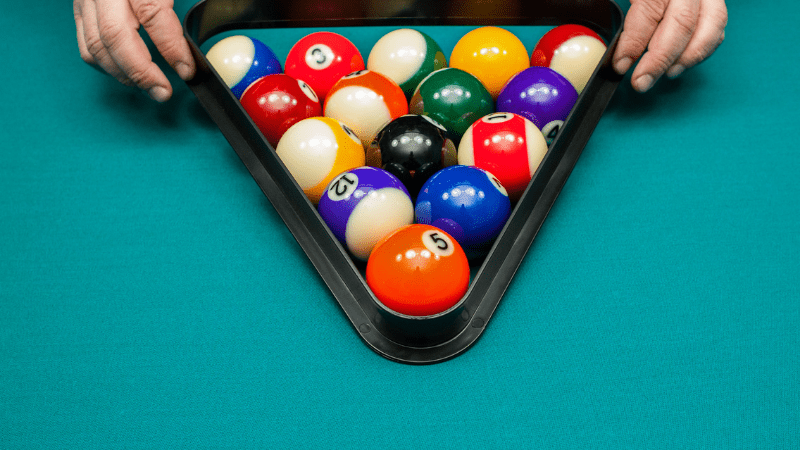One of the first signs of a novice pool player is improper racking. Before your opponent even sees how you hold a stick or line up a shot, you have to demonstrate you know how to properly rack the pool balls. This will affect the following break and, if done incorrectly, your opponent might even call you out on an illegal rack.
Therefore, if you intend to be serious about playing pool, you should know how to properly rack balls, both for 8-ball and 9-ball games, and this article will show you how to do just that. It will also cover why proper racking is important, the effects of rack manipulation, and how racking rules might vary depending on the game’s level.
Decide if You’re Playing 8-Ball or 9-Ball
You should always learn the fundamentals of any billiards game, including how to correctly set up the table and rack the balls. While there are a few things that 8-ball and 9-ball have in common, racking is not one of them. Considering these are two of the most popular and commonly played billiard games, we’ll show you how to rack for each correctly, so you look like a pool shark from the very beginning.
Because 8-ball and 9-ball require different amounts of balls, this changes their formation, and ultimately, how the balls are racked. Regular 8-ball is undoubtedly the most popular billiards game, and its rack entails a triangular formation with the classic 8-ball in the center, a striped ball in one back corner, and a solid ball in the opposing back corner.
If you’re playing 9-ball, it’s a classic shooter’s game the utilizes a diamond-shaped formation where the 1-ball has to be at the apex of the diamond, and the 9-ball must be at the center.
A good rule of thumb is whatever ball is the game’s name should be placed in the center of the formation. Once the essential balls are where they need to be, the rest of the formation can be filled randomly with any ball regardless of pattern or number.
However, there are some exceptions for each game, depending on the level you are playing at. For example, most recreational games will follow the rules above, but professional games will have stricter racking rules.
If You’re Playing 8-Ball, Follow These Pro Racking Rules
When you reach the pro levels for any billiards game, the rules automatically become much stricter down to the very degree of the rack’s formation placement. While we won’t get into those specifics, you should know some of the additional racking rules at this level.
For 8-ball, the triangular formation needs to be placed correctly at the foot of the table. The base of the rack should be parallel to the short end of the table so that the tip of the formation is located on the center of the foot stop. If you’re new to pool, you’ll want to look up the different sections of a pool table for future reference.
Although it is not a universal rule, there are some leagues that don’t allow any row to be made up of balls from the same set (meaning all stripes or all solids), which is where some people get the idea of alternating solids and stripes when racking. Even though this isn’t always required, it isn’t a bad racking habit to have.
The final rule of pro 8-ball pool (or any pro billiards game) is to never touch any ball within the formation once the rack has been removed. Additionally, if any ball is touched or repositioned, a re-rack must occur.
If You’re Playing 9-Ball, Follow These Pro Racking Rules
Pro level 9-ball also has its exceptions you should be aware of, mostly to prevent any rack manipulation.
When you start placing balls within the diamond formation, make sure to follow the rules of placing the 1-ball at the apex and on the foot spot with the 9-ball in the center. In addition to this, it is important the rack is tight with no intentional gaps between the balls, and all other balls must be placed randomly with no signs of an intentional pattern.
If it looks like you are intentionally placing the balls in specific spots within the formation or creating gaps, a re-rack will be required.
The angle of the formation is also important in this game. Tilting the formation so the alignment is off to one side would affect any break from the box and could be considered cheating if done intentionally. Therefore, you’ll want to make sure there is proper alignment through the 1, 9, and rear tip ball to ensure all breaks are fair. You can check rack alignment easily by placing a laser level down the center string of the table.
Make Sure You’re Not Accidentally Cheating
Some of you might be thinking you want to play 8 Ball or 9 Ball recreationally, so why should you care about all of these specific racking rules? The answer is because it could ultimately turn the tides for or against you.
Whether it is done intentionally or unintentionally, incorrect racking is often considered a form of rack manipulation or cheating and could easily sway an 8-Ball or 9-Ball game in one player’s favor. The higher the level of player, the stricter the rules become to ensure all games are fair from start to finish.
You’d be surprised the tricks smart cheaters will deploy to manipulate a rack and give them an unfair advantage. If the player is about the break, they could add gaps between specific balls to ensure they kiss off each other in just the right way to allow a “golden break.” Alternatively, they could add gaps, feather balls, or alter the alignment to hinder their opponent’s break.
All of these are examples of very poor sportsmanship and are grounds for a re-rack or penalties for cheating.
Final Thoughts
Learning the correct rack orders and formations for 8-ball and 9-ball are crucial to the fundamentals of both games. We highly recommend you learn these rules, along with the layout of a table for each game, before progressing to strategies and tricks.
Not only will it help you look like you know what you’re doing, but it will also help you recognize when an opponent is trying to manipulate the rack against you. When in doubt, it never hurts to request a re-rack to ensure everything is set up correctly for a fair game.

